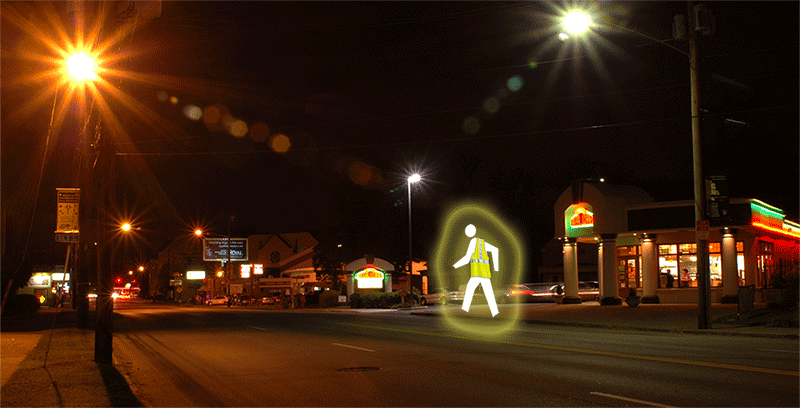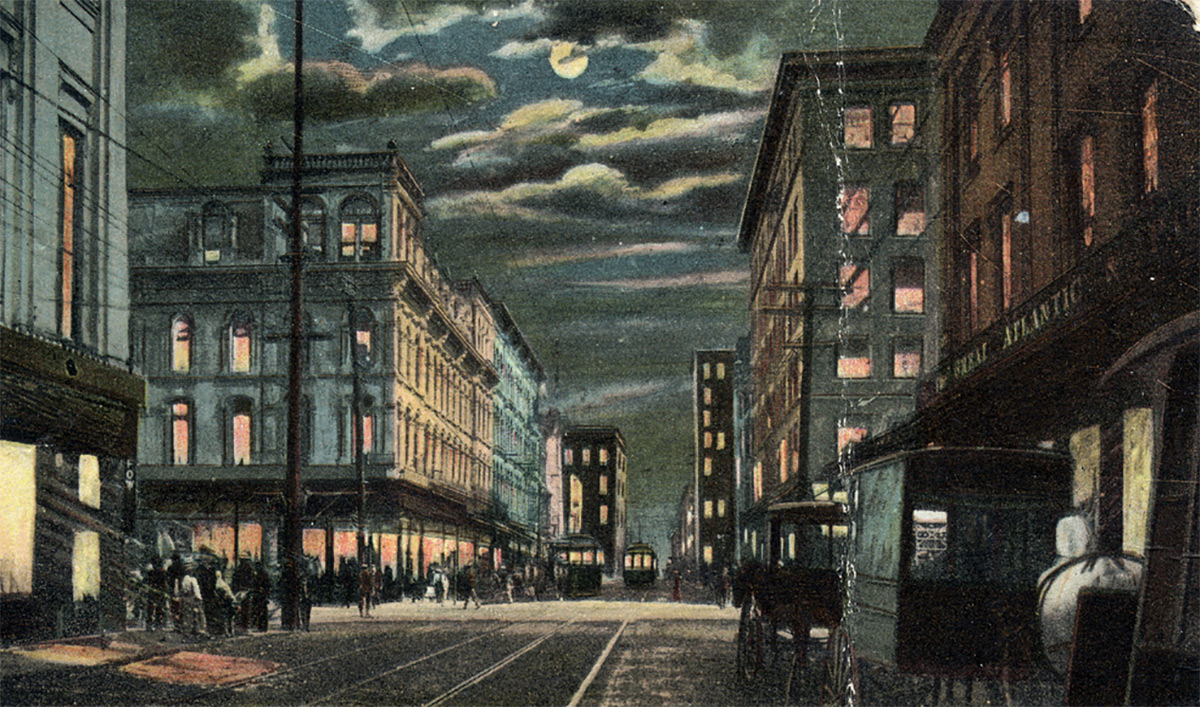[Editor’s Note: This is one piece in a multiple-part series about street safety in Louisville as the city continues to roll out its three-year pedestrian safety campaign, Look Alive Louisville. View the entire series here.]
If you’re out walking after sundown, you’d better be glowing in the dark or else it’s your own fault if you get hit and killed by a motorist. As part of the city’s Look Alive Louisville pedestrian-safety campaign, one approach of the Louisville Metro Police Department has been to blame the victim. The LMPD claims that a large amount of pedestrian deaths are the the fault of the victim—and one thing that the LMPD says makes a crash your fault is wearing dark clothing. According to LMPD figures, last year 49 pedestrians were struck while wearing dark clothing, with four fatalities.

Municipalities who want to appear like they’re addressing pedestrian safety suggest—in the name of safety—that their pedestrians don reflective clothing and lights. They put the burden of safety on the pedestrian rather than the person driving the two-ton car capable of doing real damage.
This exact scenario is playing out right now in Louisville. The Look Alive Louisville website suggests that pedestrians “Wear bright colors, Wear reflective clothing, [and] Carry a flashlight.” Adding, “Make eye contact with drivers so you understand their intentions and they understand yours.” The Courier-Journal even went as far as to suggest that Louisville pedestrians wear silly reflective vests as they walk around our city.
The same recommendations were lambasted on Streets.mn earlier this year when writer Nathaniel Hood said, “You might look ridiculous, but it’s better than being dead or having driver’s to slow down or designing our streets and places for people.” Eben Weiss also addressed the problem in his Washington Post piece, “Don’t make bicyclists more visible. Make drivers stop hitting them.”
Bike Louisville’s cyclist and pedestrian coordinator Rolf Eisinger told Broken Sidewalk:
The more we can all do to stay safe collectively—to stay more visible—the better off we’re all going to be. If you are a pedestrian who is going to be walking at dusk and dawn, it would be more safe if you wore brighter clothes or a blinky light if you’re walking your dog or walking to the bus stop, or wear reflective apparel. It just makes you easier for your fellow motorists to see you in those dim or dusk light conditions.

This line of thinking sets up a narrative that enables victim blaming. If a pedestrian didn’t have a flashlight, they are responsible for his or her own death. If someone is wearing dark clothing, they’re just asking to be hit by a motorist.
This notion of “pedestrian error” is pervasive in how stories of pedestrian death and injury and reported and investigated. Longbeachize describes the common problem among media covering traffic violence, noting that reporters tend to “call the cops, ask for reasons, and play on those reasons provided,” which can inadvertently set up an article that blames the victim.

As Next City’s Rachel Dovey pointed out last August, “pedestrian error” doesn’t tell the whole story. “There are a lot of areas where the choice is to be in the roadway or in the grass or a mud path,” Baltimore urban planner Allysha Lorber told Dovey . “Sometimes there’s a sidewalk but often it’s bumpy or has poles sticking out of it or is overgrown with vegetation. There aren’t a lot of crosswalks, and pedestrians are everywhere.”
It’s difficult to collect data from scenes of traffic violence. “The determination of fault happens for civil liability — whether the drivers’ insurance company is paying,” Heather Strassberger, a professor and former city planner in Baltimore told Dovey. “That doesn’t allow for the officer to determine that both users are doing the best they can on an imperfect road and that the road wasn’t designed very well. It doesn’t cover the whole picture.” Dovey also points out: “The determination comes partly from the motorist’s word against the pedestrian’s and — in the case of fatal accidents — the walker is dead.”
[Top image by The Pug Father / Flickr; montage by Broken Sidewalk.]



LookingStupidLouisvilleLightUpLouisvilleMoveForwardVisionSustainLouisville. Bleah!
DupedLouisville. Maybe crack down on the cell phone using drivers who (this all yesterday ) ran the stop sign at Cherokee and Willow, blew the light at Second and Chestnut, and turned in front of me at Second and Guthrie. Geez.
Hello. I fear you have gone quite mad. I walk and drive in the Highlands, and because it is such a “walkable” area, people tend to… jaywalk. They tend to open their car doors without concern for any oncoming traffic. They amble out of their cars, and cross the street because they’re going to “their” bar in “their” neighborhood. It’s an understandable mistake to make. Car drivers should be alert. They should obey the laws. They should try not to hit people at all times. Pedestrians should never jaywalk. They should only cross when they have a signal. If they are in a stretch of road that has no convenient crosswalks, they cross at their own peril, just as drivers take a risk that other drivers, bicyclists or orbiting space stations might collide with them at some point. Cars have lights on them. Lights and horns and a structure that protects the passengers from mild collisions. Pedestrians usually have no such safety measures. Making Louisville “walkable” and “bike friendly” will result in some accidents, as cars are everywhere. It should be common sense that drivers should not hit people, and pedestrians should not step into oncoming traffic. Yet it happens. What to do? I do not see the need to make drivers 100% villains and pedestrians 100% innocents in this situation. But, again, I feel you’ve gone quite mad.
Jay walking is the only reasonable course of action on much of our roadways when cross walks only exist every 1/4 mile. Asking a pedestrian to walk an extra 15 minutes in order to cross safely is absurd.
Yes carefree jay walking is a safety hazard, but it is usually a symptom of poorly designed systems and transit systems.
No matter how visible you are, a texting driver, or a driver rummaging through his glove compartment won’t see you. I wonder what Louisville police are doing to prevent distracted driving.